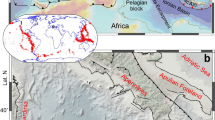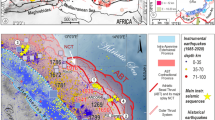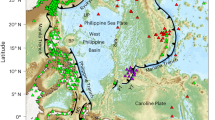Abstract
Lithospheric-scale transform faults play an important role in the dynamics of global plate motion. Near-surface deformation fields for such faults are relatively well documented by satellite geodesy, strain measurements and earthquake source studies1,2, and deeper crustal structure has been imaged by seismic profiling3. Relatively little is known, however, about deformation taking place in the subcrustal lithosphere—that is, the width and depth of the region associated with the deformation, the transition between deformed and undeformed lithosphere and the interaction between lithospheric and asthenospheric mantle flow at the plate boundary. Here we present evidence for a narrow, approximately 20-km-wide, subcrustal anisotropic zone of fault-parallel mineral alignment beneath the Dead Sea transform, obtained from an inversion of shear-wave splitting observations along a dense receiver profile. The geometry of this zone and the contrast between distinct anisotropic domains suggest subhorizontal mantle flow within a vertical boundary layer that extends through the entire lithosphere and accommodates the transform motion between the African and Arabian plates within this relatively narrow zone.
This is a preview of subscription content, access via your institution
Access options
Subscribe to this journal
Receive 51 print issues and online access
$199.00 per year
only $3.90 per issue
Buy this article
- Purchase on Springer Link
- Instant access to full article PDF
Prices may be subject to local taxes which are calculated during checkout




Similar content being viewed by others
References
Holt, W. E., Bingming, S.-T., Haines, J. & Jackson, J. in The History and Dynamics of Global Plate Motions (eds Richards, M. A., Gordon, R. G. & van der Hilst, R. D.) 113–141 (American Geophysical Union, Washington DC, 2000)
Shachak, P. et al. Current plate motion across the Dead Sea Fault from three years of continuous GPS monitoring. Geophys. Res. Lett. 29, 10.1029/2001GL013879 (2002)
Stern, T. A. & McBride, J. H. Seismic exploration of continental strike-slip zones. Tectonophysics 286, 63–78 (1998)
Ben-Menahem, A., Nur, A. & Vered, M. Tectonics, seismicity and structure of the Afro-Eurasian junction — the breaking of an incoherent plate. Phys. Earth Planet. Inter. 12, 1–50 (1976)
Garfunkel, Z. Internal structure of the Dead Sea leaky transform (rift) in relation to plate kinematics. Tectonophysics 80, 81–108 (1981)
Van Eck, T. & Hofstetter, A. Microearthquake activity in the Dead Sea region. Geophys. J. Int. 99, 605–620 (1989)
Quennel, A. M. The structural and geomorphic evolution of the Dead Sea rift. Q. J. Geol. Soc. Lond. 114, 2–24 (1958)
Freund, R. et al. The shear along the Dead Sea rift. Phil. Trans. R. Soc. Lond. A 267, 107–130 (1970)
McKenzie, D. P., Davies, D. & Molnar, P. Plate tectonics of the Red Sea and East Africa. Nature 224, 125–133 (1970)
Mart, Y. & Rabinowitz, P. The northern Red Sea and the Dead Sea Rift. Tectonophysics 124, 85–113 (1986)
Zhang, S. & Karato, S. Lattice preferred orientation of olivine aggregates deformed in simple shear. Nature 375, 774–777 (1995)
Tommasi, A., Tikoff, B. & Vauchez, A. Upper mantle tectonics: Three-dimensional deformation, olivine crystallographic fabrics and seismic properties. Earth Planet. Sci. Lett. 168, 173–186 (1999)
Silver, P. G. & Chan, W. W. Implications for continental structure and evolution from seismic anisotropy. Nature 335, 34–39 (1988)
Savage, M. K. & Marson-Pidgeon, K. Frequency dependent anisotropy in Wellington, New Zealand. Geophys. Res. Lett. 24, 3289–3300 (1997)
Desert Team, Multinational geoscientific research kicks off in the Middle East. Eos 81, 609, 616–617 (2000)
Kind, R., Kosarev, G. L., Makeyeva, L. I. & Vinnik, L. P. Observations of laterally inhomogeneous anisotropy in the continental lithosphere. Nature 318, 358–361 (1985)
Silver, P. G. Seismic anisotropy beneath the continents: Probing the depths of geology. Annu. Rev. Earth Planet. Sci. 24, 385–432 (1996)
Crampin, S. Geological and industrial implications of extensive-dilatancy anisotropy. Nature 328, 491–496 (1987)
Sobolev, S. V., Babeyko, A. Y. & Garfunkel, Z. Desert Group. Thermo-mechanical model of the Dead Sea Transform. Earth Planet. Sci. Lett. (submitted)
Wolfe, C. J., Vernon, F. L. III & Al-Amri, A. Shear-wave splitting across western Saudi Arabia: The pattern of upper mantle anisotropy at a Proterozoic shield. Geophys. Res. Lett. 26, 779–782 (1999)
Reinecker, J., Heidbach O. & Müller, B.The 2003 release of the World Stress Map 〈http://www.world-stress-map.org/〉 (2003).
Bartov, Y., Avni, Y., Calvo, R. & Frieslander, U. The Zofar fault — A major intra-rift feature in the Arava Rift Valley. Geol. Surv. Israel Curr. Res. 11, 27–32 (1998)
Savage, M. K. Seismic anisotropy and mantle deformation: What have we learned from shear wave splitting? Rev. Geophys. 37, 65–106 (1999)
McNamara, D. E., Owens, T. J., Silver, P. G. & Wu, F. T. Shear wave anisotropy beneath the Tibetan Plateau. J. Geophys. Res. 99, 13655–13665 (1994)
Hirn, A. et al. Seismic anisotropy as an indicator of mantle flow beneath the Himalayas and Tibet. Nature 375, 571–574 (1995)
Herquel, G., Tapponnier, P., Wittlinger, G., Mei, J. & Danian, S. Teleseismic shear wave splitting and lithospheric anisotropy beneath and across the Altyn Tagh fault. Geophys. Res. Lett. 26, 3225–3228 (1999)
Nicolas, A. & Christensen, N. I. in Composition, Structure and Dynamics of the Lithosphere-Asthenosphere System (eds Fuchs, K. & Froidevaux, C.) Geodyn. Ser. 16, 111–123 (1987)
Acknowledgements
We are grateful to the Geophysical Institute of Israel, the National Ministry of Infrastructure of Israel, the Natural Resources Authority of Jordan, and the An-Najah University in Nablus, Palestine Authority, for their support. The instruments were provided by the Geophysical Instrument Pool of the GeoForschungsZentrum Potsdam. The experiment was supported by the Deutsche Forschungsgemeinschaft, the GeoForschungsZentrum Potsdam, and the Minerva Dead Sea Research Centre.
Author information
Authors and Affiliations
Corresponding author
Ethics declarations
Competing interests
The authors declare that they have no competing financial interests.
Rights and permissions
About this article
Cite this article
Rümpker, G., Ryberg, T., Bock, G. et al. Boundary-layer mantle flow under the Dead Sea transform fault inferred from seismic anisotropy. Nature 425, 497–501 (2003). https://doi.org/10.1038/nature01982
Received:
Accepted:
Issue Date:
DOI: https://doi.org/10.1038/nature01982
This article is cited by
-
Seismic anisotropy accrued by seven unusually deep local earthquakes (between 50 and 60 km) in the Albertine Rift: implications of asthenospheric melt upwelling
Journal of Seismology (2021)
-
Characteristics of high-frequency attenuation in the Dead Sea Basin
Journal of Seismology (2020)
-
Seismic anisotropy structure beneath the southeastern Mediterranean from shear-wave splitting
Arabian Journal of Geosciences (2013)
-
Shear Wave Splitting and Mantle Anisotropy: Measurements, Interpretations, and New Directions
Surveys in Geophysics (2009)
-
Combining satellite and seismic images to analyse the shallow structure of the Dead Sea Transform near the DESERT transect
International Journal of Earth Sciences (2008)
Comments
By submitting a comment you agree to abide by our Terms and Community Guidelines. If you find something abusive or that does not comply with our terms or guidelines please flag it as inappropriate.



